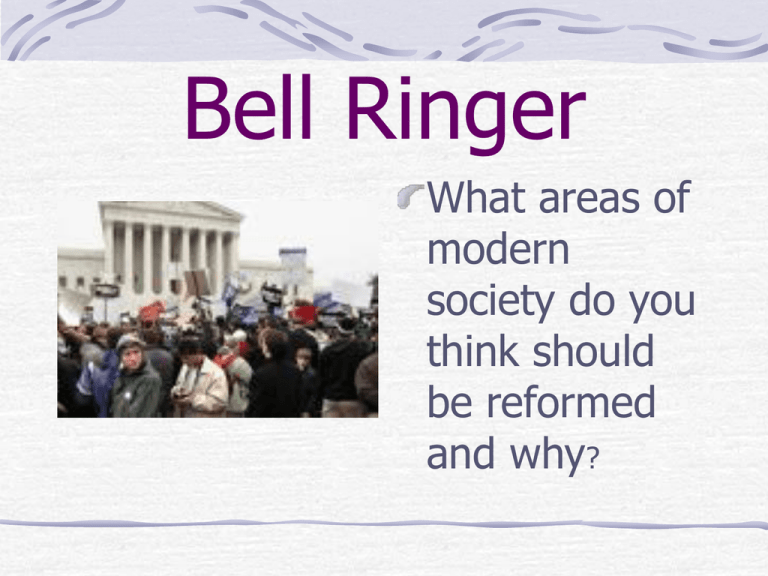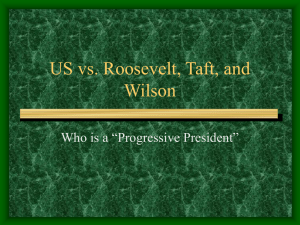The Progressive Era - Rolla Public Schools
advertisement

Bell Ringer What areas of modern society do you think should be reformed and why? The Progressive Era Amid great political and social change, women gain a larger public role and lead the call for reform. President Theodore Roosevelt dubs his reform policies a Square Deal. The Progressive Era Concerns of Progressives Different reform efforts collectively called progressive movement Four Goals of Progressivism 1. Protecting Social Welfare Florence Kelley, political activist, advocate for women, children - helps pass law prohibiting child labor, limiting women’s hours 2. Promoting Moral Improvement Prohibition—banning of alcoholic drinks Woman’s Christian Temperance Union spearheads prohibition crusade Prohibition Four Goals of Progressivism 3. Creating Economic Reform • 1893 panic prompts doubts about capitalism; many become socialists • Muckrakers—journalists who expose corruption in politics, business 4. Fostering Efficiency • Scientific management—time and motion studies applied to workplace • Assembly lines speed up production, make people work like machines - cause high worker turnover Muckrakers Reforming Elections Oregon adopts secret ballot, initiative, referendum, recall • Initiative—bill proposed by people, not lawmakers, put on ballots • Referendum—voters, not legislature, decide if initiative becomes law • Recall—voters remove elected official through early election • Primaries allow voters, not party machines, to choose candidates Direct Election of Senators • Seventeenth Amendment permits popular election of senators Bell Ringer List the Four Goals of Progressivism Recall Women in Public Life As a result of social and economic change, many women enter public life as workers and reformers. Women Lead Reform Women in Higher Education Many women active in public life have attended new women’s colleges 50% college-educated women never marry; many work on social reforms Women and Reform A Three-Part Strategy for Suffrage 1. Convince state legislatures to give women right to vote 2. Test 14th Amendment—states lose representation if deny men vote 3. Push for constitutional amendment to give women the vote Teddy Roosevelt’s Square Deal As president, Theodore Roosevelt works to give citizens a Square Deal through progressive reforms A Rough-Riding President Roosevelt’s Rise • Theodore Roosevelt has sickly childhood, drives self in athletics • Is ambitious, rises through New York politics to become governor • NY political bosses cannot control him, urge run for vice-president A Rough-Riding President The Modern Presidency President McKinley shot; Roosevelt becomes president at 42 His leadership, publicity campaigns help create modern presidency Supports federal government role when states do not solve problems - Square Deal—Roosevelt’s progressive reforms Square Deal Trustbusting Using Federal Power Roosevelt wants to curb trusts that hurt public interest - breaks up some trusts under Sherman Antitrust Act 1902 Coal Strike Coal reserves low; forces miners, operators to accept arbitration Sets principle of federal intervention when strike threatens public Health and the Environment Regulating Foods and Drugs • Upton Sinclair’s The Jungle—unsanitary conditions in meatpacking • Roosevelt commission investigates, backs up Sinclair’s account • Roosevelt pushes for Meat Inspection Act: - dictates sanitary requirements - creates federal meat inspection program The Jungle Health and the Environment Pure Food and Drug Act • Food, drug advertisements make false claims; medicines often unsafe • Pure Food and Drug Act halts sale of contaminated food, medicine - requires truth in labeling Conservation and Natural Resources 1887, U.S. Forest Bureau established, manages 45 million acres Private interests exploit natural environment Roosevelt sets aside forest reserves, sanctuaries, national parks Believes conservation part preservation, part development for public Roosevelt and Civil Rights Roosevelt does not support civil rights for African Americans • Supports individual African Americans in civil service - invites Booker T. Washington to White House • NAACP—National Association for the Advancement of Colored People - goal is full equality among races • Founded 1909 by W. E. B. Du Bois and black, white reformers Progressivism Under Taft Taft’s ambivalent approach to progressive reform leads to a split in the Republican Party and the loss of the presidency to the Democrats. Taft Stumbles 1908, Republican William Howard Taft wins with Roosevelt’s support Has cautiously progressive agenda; gets little credit for successes Does not use presidential bully pulpit to arouse public opinion The Bull Moose Party 1912 convention, Taft people outmaneuver Roosevelt’s for nomination Progressives form Bull Moose Party; nominate Roosevelt, call for: - more voter participation in government - woman suffrage - labor legislation, business controls Runs against Democrat Woodrow Wilson, reform governor of NJ Democrats Win in 1912 Wilson endorses progressive platform called the New Freedom - wants stronger antitrust laws, banking reform, lower tariffs - calls all monopolies evil Roosevelt wants oversight of big business; not all monopolies bad Wilson wins great electoral victory; gets majority in Congress Bell Ringer Explain why President Taft lost his re-election bid in 1912 Wilson Wins Financial Reforms Wilson’s Background Wilson was lawyer, professor, president of Princeton, NJ governor As president, focuses on trusts, tariffs, high finance Two Key Antitrust Measures Clayton Antitrust Act stops companies buying stock to form monopoly • Ends injunctions against strikers unless threaten irreparable damage • Federal Trade Commission (FTC)— new “watchdog” agency - investigates regulatory violations - ends unfair business practices Wilson Wins Financial Reforms A New Tax System Wilson pushes for Underwood Act to substantially reduce tariffs Sets precedent of giving State of the Union message in person His use of bully pulpit leads to passage Federal Income Tax Sixteenth Amendment legalizes graduated federal income tax Wilson Wins Financial Reforms Federal Reserve System • Federal Reserve System—private banking system under federal control • Nation divided into 12 districts; central bank in each district Women Win Suffrage College-educated women spread suffrage message to workingclass • Go door-to-door, take trolley tours, give speeches at stops 1920 Nineteenth Amendment grants women right to vote The Twilight of Progressivism Outbreak of World War I distracts Americans; reform efforts stall








